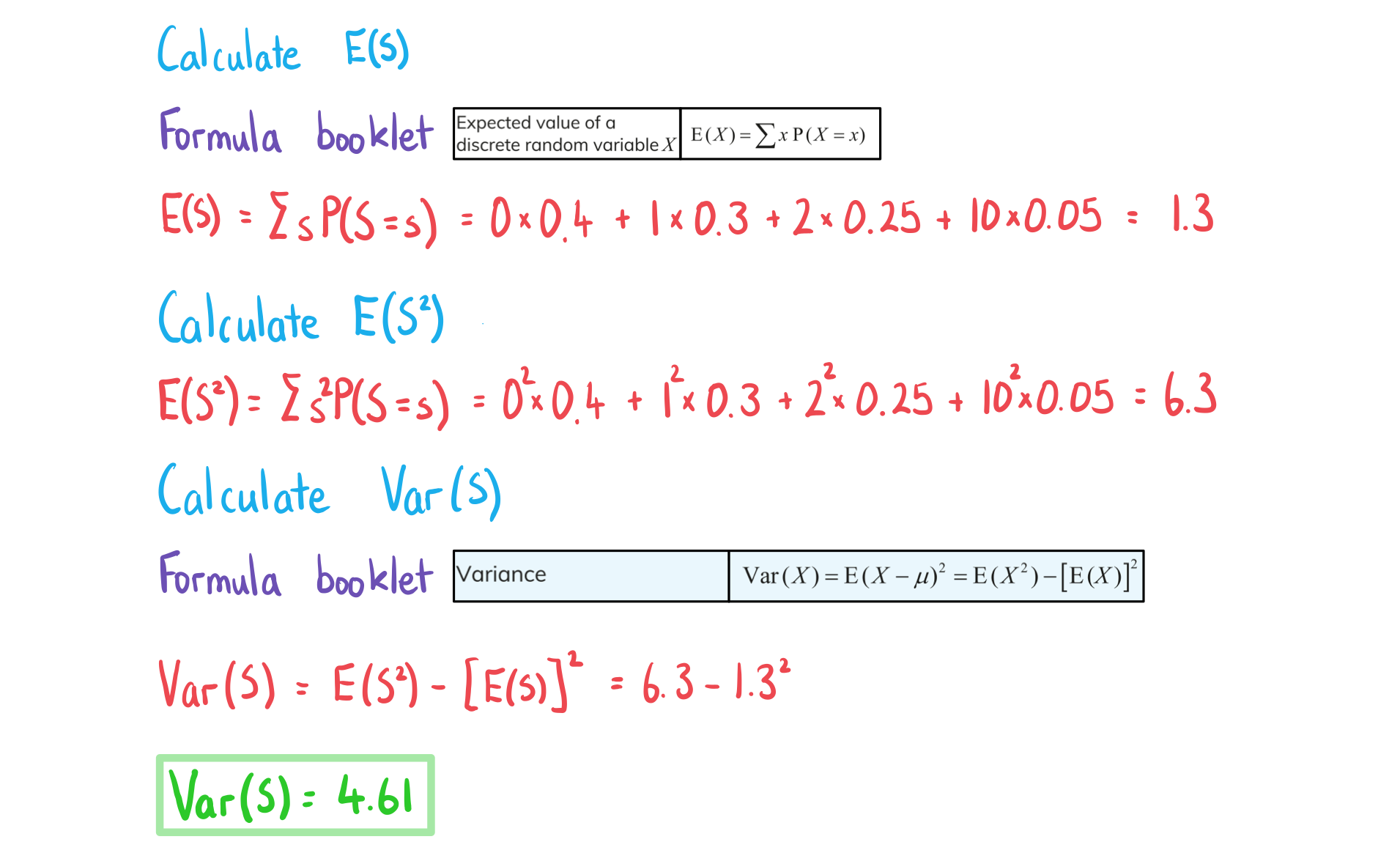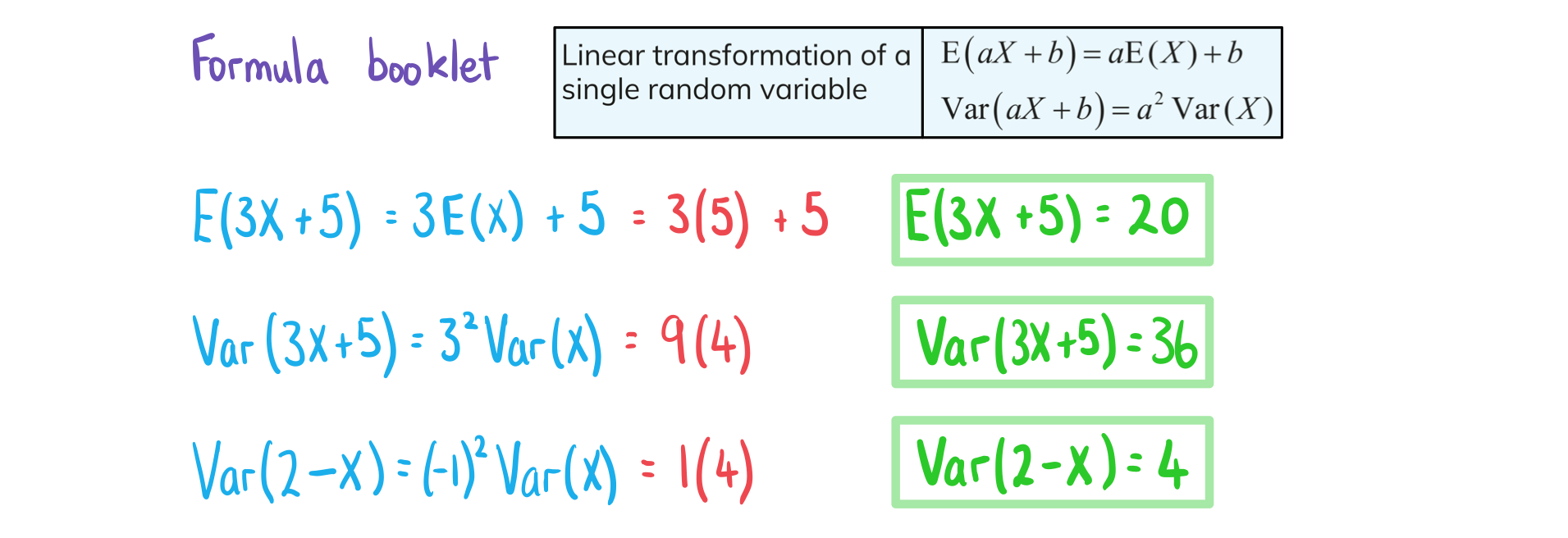Expected Values E(X)
What does E(X) mean and how do I calculate E(X)?
- E(X) means the expected value or the mean of a random variable X
- The expected value does not need to be an obtainable value of X
- For example: the expected value number of times a coin will land on tails when flipped 5 times is 2.5
- For a discrete random variable, it is calculated by:
- Multiplying each value of
with its corresponding probability
- Adding all these terms together
- Multiplying each value of
-
-
- This is given in the formula booklet
-
- Look out for symmetrical distributions (where the values of X are symmetrical and their probabilities are symmetrical) as the mean of these is the same as the median
- For example: if X can take the values 1, 5, 9 with probabilities 0.3, 0.4, 0.3 respectively then by symmetry the mean would be 5
How can I decide if a game is fair?
- Let X be the random variable that represents the gain/loss of a player in a game
- X will be negative if there is a loss
- Normally the expected gain or loss is calculated by subtracting the cost to play the game from the expected value of the prize
- If E(X) is positive then it means the player can expect to make a gain
- If E(X) is negative then it means the player can expect to make a loss
- The game is called fair if the expected gain is 0
- E(X) = 0
Worked Example
Daphne pays $5 to play a game where she wins a prize of $1, $5, $10 or $100. The random variable represents the amount she wins and has the probability distribution shown in the following table:
| 1 | 5 | 10 | 100 | |
| 0.35 | 0.5 | 0.05 | 0.01 |
a)
Calculate the expected value of Daphne's prize.

b)
Determine whether the game is fair.

Variance Var(X)
What does Var(X) mean and how do I calculate Var(X)?
- Var(X) means the variance of a random variable X
- The standard deviation is the square root of the variance
- This provides a measure of the spread of the outcomes of X
- The variance and standard deviation can never be negative
- The standard deviation is the square root of the variance
- The variance of X is the mean of the squared difference between X and the mean
-
- This is given in the formula booklet
- This formula can be rearranged into the more useful form:
- This is given in the formula booklet
- Compare this formula to the formula for the variance of a set of data
- This formula works for both discrete and continuous X
How do I calculate E(X²) for discrete X?
- E(X²) means the expected value or the mean of the random variable defined as X²
- For a discrete random variable, it is calculated by:
- Squaring each value of X to get the values of X2
- Multiplying each value of X2 which its corresponding probability
- Adding all these terms together
- This is given in the formula booklet as part of the formula for Var(X)
- E(f(X)) can be found in a similar way
Is E(X²) equal to E(X)²?
- Definitely not!
- They are only equal if X can only take one value
- E(X²) is the mean of the values of X²
- E(X)² is the square of the mean of the values of X
- To see the difference
- Imagine a random variable X that can only take 1 and -1 with equal chance
- E(X) = 0 so E(X)² = 0
- The square values are 1 and 1 so E(X²) = 1
Exam Tip
- In an exam you can enter the probability distribution into your GDC using the statistics mode
- Enter the possible values as the data
- Enter the probabilities as the frequencies
- You can then calculate the mean and variance just like you would with data
Worked Example
The score on a game is represented by the random variable defined below.
|
0 |
1 |
2 |
10 |
|
|
0.4 |
0.3 |
0.25 |
0.05 |
Calculate .

Transformation of a Single Variable
How do I calculate the expected value and variance of a transformation of X?
- Suppose X is transformed by the function f to form a new variable T = f(X)
- This means the function f is applied to all possible values of X
- Create a new probability distribution table
- The top row contains the values
- The bottom row still contains the values
which are unchanged as:
- Some values of T may be equal so you can add their probabilities together
- The top row contains the values
- The mean is calculated in the same way
- The variance is calculated using the same formula
Are there any shortcuts?
- There are formulae which can be used if the transformation is linear
where a and b are constants
- If the transformation is not linear then there are no shortcuts
- You will have to first find the probability distribution of T
What are the formulae for E(aX ± b) and Var(aX ± b)?
- If a and b are constants then the following formulae are true:
- E(aX ± b) = aE(X) ± b
- Var(aX ± b) = a² Var(X)
- These are given in the formula booklet
- This is the same as linear transformations of data
- The mean is affected by multiplication and addition/subtraction
- The variance is affected by multiplication but not addition/subtraction
- Remember division can be written as a multiplication
Worked Example
is a random variable such that
and
.
Find the value of:
(i)
(ii)
(iii)

